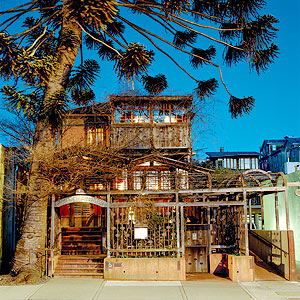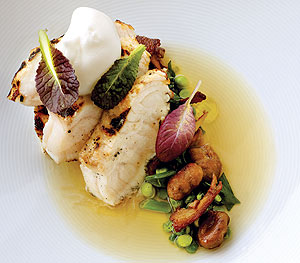|
In 1971, when Alice Waters opened Chez Panisse in Berkeley, California, canned, frozen, and heavy food were rife in American restaurants; her plan to emphasize seasonal, light, artisanal ingredients from local farms seemed eccentric, at best. Thirty-six years later, it’s gospel. Chicago chefs have embraced her style-Italian influenced, French technique-particularly at Blackbird and North Pond. I wanted to see how those two spots compared to two Bay Area counterparts: San Francisco’s Restaurant Gary Danko, and the epicenter of the revolution itself, Chez Panisse.
* * *
It figures that Chez Panisse, the birthplace of California cuisine, looks like a rustic wood house. Waters gave the soothing, low-key Arts and Crafts décor a makeover after a fire some years ago. I last ate there in the mid-1970s, before the renovation, and now the kitchen is completely open. Nothing separates tables from the woodburning grill and roaster-which gives the dining room a mouthwatering hardwood smoke aroma. The current chef lineup-Jean-Pierre Moullé presides for half the year, then hands over the reins to David Tannis-ably carries on the restaurant’s style and enduring reputation. A tall order: they’re in the footsteps of giants like Paul Bertolli, Jeremiah Tower, and Waters herself.
The terrific breads that start the meal are baked by Acme Bakery, an enterprise that began in Chez Panisse’s kitchen and now resides a few blocks away. CP’s set menu changes daily; my meal began with a salad of Maine lobster nuggets with sliced fennel around a central mound of what appeared to be just-picked frisée topped with blood orange supremes and dressed with blood orange vinaigrette. Stunning. The potato gnocchi may have been the lightest and tenderest I’ve ever tasted, fabulous with surprisingly restrained black truffle butter and tiny forest mushrooms. Thank goodness there was still a bit of bread at hand to sop up the last drops of sauce.
A pork loin from the whimsically named Laughing Stock Farms was stuffed with green garlic and rosemary, roasted on the rotisserie, and served on a bed of tatsoi greens with two lean strips of grilled pork leg. Surrounded by celery root, parsnips, and carrots with baby turnips, the loin was vastly more tender and juicy than 99 percent of the pork out there-the decadent coating of fat didn’t hurt. And the pork and vegetable flavors were in Zenlike harmony. We got a medium-bodied 2005 Broadley pinot noir from Willamette Valley ($62) that was good with the lobster and gnocchi and perfect with the pork.
As we were finishing our melting-soft bittersweet chocolate fondant with espresso ice cream and hazelnuts, my friend noticed that other diners were drifting into the open kitchen. We soon followed and were amazed. There’s a long counter where staff work their stations, and patrons chatted with them about what they were doing, beginning with the gray-haired Chef Moullé, who manned the wood grill and rotisserie and finished the plates. This was the most relaxed team I’ve ever seen in a kitchen, happy to explain their jobs to customers. They looked thrilled to be working at Chez Panisse. Alice Waters didn’t just kick-start a culinary revolution from the little house in downtown Berkeley-she created an amazing atmosphere to go with it.
* * *
Gary Danko learned the intricacies of California cuisine in Napa and Sonoma counties in the eighties, and he learned them well: his seven-year-old namesake restaurant perennially scores top ratings in the San Francisco Zagat Survey. On a corner near Fisherman’s Wharf, it’s elegantly appointed but cramped and somewhat noisy. The windows are blacked out, which adds to the exclusive, private atmosphere, and the night I was there, two big Buddha heads in the dining room accented the local San Francisco culture.
Danko’s food has the same underlying theme as Chez Panisse’s-but these days, it’s considerably better, perhaps because Danko has stretched the Waters philosophy with more complex ingredients and presentation. His signature plate of delicately glazed oysters with osetra caviar came with seasonal puréed salsify and lettuce cream instead of the zucchini pearls seen at other times of the year. Treviso (a cousin of radicchio) and romaine salad with Banyuls vinaigrette, anchovies, and Parmigiano-Reggiano was beautifully arranged and deliciously light. I don’t know what pond he gets them from, but Danko’s frogs’ legs, tightly wrapped in pancetta and looking like tiny amphibian corn dogs, were fantastic finger food, served with sunchoke garlic purée and lentils. My Stanford University companions brought their own terrific red wines for the meat dishes, but for this course, we ordered a sommelier-recommended 2005 Diatom Clos Pepe California Chardonnay ($78), one of the less expensive wines on the formidable list. It was excellent: steely, not oaky, in more of a French style.
Entrées were equally impressive. Menu descriptions don’t bother to list the sauces, but my guess is that they are meat reductions with different herbs and no flour thickening, in the modern California style. All very diverse. Guinea hen breast and confit leg with quince, Brussels sprouts, and cornbread pudding-a rich American version of polenta-was irresistible. I felt the same way about the juniper-crusted venison with cranberry compote, braised endive, and wonderful chestnut spätzle, as well as the final dessert of sweet-spiced persimmon pudding. Like Chez Panisse, Restaurant Gary Danko may no longer have the field to itself, but it has an assured grasp on the heart of California cuisine.
* * *
|
Seems the rest of the dining world has caught up with California. These days, any chef worth his fleur de sel zeroes in on seasonal ingredients and local purveyors-so much so that what was known as California cuisine has morphed into something called contemporary American. A perfect example is Paul Kahan’s Blackbird. Since its 1997 opening, Blackbird has painstakingly built up all the right credentials: Kahan buys produce from Wisconsin Homegrown, an organic farmers’ cooperative; he rides his bike to local markets; and he plans to hire a “forager” to seek out foods for him (an old Waters trick). The narrow, minimalist room-much more New York than San Francisco-is by now a Chicago legend.
I lucked into my favorite table near the display kitchen and tried to figure out which guy was Mike Sheerin, the new chef de cuisine. Soon I was digging into an appetizer of crisp confit of Swan Creek Farm suckling pig with cavolo nero (black Tuscan kale), shaved radish, and a pungent kick of horseradish and Banyuls vinegar. I was almost too busy to notice how enthralled a companion was with his huge portion of crisp veal sweetbreads and Maine sweet shrimp with red kuri squash and pickled mustard seeds, all in a bowl holding fragrant curry consommé. Another friend was reluctant to give up her tender confit of baby octopus and duck prosciutto with cocoa beans, Jerusalem artichokes, and preserved lemon, but I managed to snare a bit of the strange combo. I loved it: a little edgy, a little intimidating-equal parts Alice Waters and Alice Cooper.
Things returned to comparative normalcy in entrées of sautéed Kona kampachi fish with butternut squash, shiitakes, toasted hickory nuts, and grilled scallion aigre-doux (sour-sweet sauce), a fascinating juxtaposition of flavors and textures. Fried leg and slow-roasted loin of Royer’s Farm rabbit was pure succulence, flavored with caraway and served with white corn panisse, fresh huckleberries, and Brussels sprouts. Grilled organic veal rib eye with cornbread porridge-a not-so-distant cousin of the cornbread pudding at Gary Danko-plus rapini, black truffle, and rosemary, got a surprising jolt from the added flavor of bittersweet chocolate shavings. A spicy 2004 Ridge Three Valleys California Zinfandel ($54) was mild for a Ridge zin but it matched well with our food.
My dinner came to a fine finale with chestnut crêpes and Bosc pears with sweet ricotta and maple ice cream. Overall, Paul Kahan’s food reminded me more of Danko’s finely wrought sophistication than Chez Panisse’s straightforward simplicity. Danko’s operation easily outpaces Kahan’s for setting and presentation, but once you put a forkful in your mouth, Blackbird is Danko’s equal.
* * *
North Pond is even more outspoken about its modern American credentials. Chef/partner Bruce Sherman, one of the founders of Chicago’s Green City Market, touts on his Web site, “We seek out farmers, producers, and other artisans who take special care with their chosen craft, and can offer us exceptional products just recently harvested.” The restaurant also donates a dollar from each wine sold to organizations supporting “sustainable cuisine” and promotes its own recycling program. Alice Waters should be proud.
Sherman calls his sweetbreads “pastured.” I’m guessing that means they come from grass-fed veal, but it has such a wholesome connotation, you almost forget you’re eating a calf’s organs. Whatever, they were great with bay leaf–infused brown butter, creamy polenta, onions, and bell pepper coulis. That was a long way from his delicious parfait glass of crabmeat and saffron gêlée, sea urchin, and smoked caviar cream and his jasmine tea–crusted freshwater shrimp with Meyer lemon–radicchio salad and a crunchy sesame biscuit. Both creative, both confident.
My favorite entrée was the squab, a mace-seasoned broiled breast and confit leg in a honey-scented reduction sauce with tender sweet potato crescents and onion-raisin jam. Or maybe it was the crisp-skinned arctic char fillet with pear glacé, red and white endive marmalade, and wild rice. A smoky-toned 2004 Oregon Maysara Jamsheed pinot noir ($56) did justice to both the game and the seafood. Warm rhubarb cardamom tartelette made with almond crumble and served with tangy lemon-fresh white cheese sorbet affirmed North Pond as the 21st-century standard-bearer of the Chez Panisse philosophy. It’s not just the Arts and Crafts décor that links the two restaurants, but a purity of style that honors the purity of their ingredients.
* * *
When it comes to California cuisine, creativity usually takes a back seat to ingredients. The dishes I tried at Chez Panisse and Gary Danko didn’t amaze me with daredevil presentations; they bowled me over with sheer flavor. Chicago chefs like Paul Kahan and Bruce Sherman have thoroughly absorbed this culinary philosophy and are seeking out local sources of fine ingredients to fulfill it. The big difference, as I see it, is their dedication to Midwestern heartiness-the bounty of suckling pig, pork bellies, and sweetbreads at Blackbird; jams and marmalades at North Pond. In a West Coast–versus–Midwest battle for mastery of contemporary American cuisine, Waters and Danko edge out Kahan and Sherman but, as usual, enterprising Chicagoans have taken something good, given it a vigorous kick, and made it their own.
* * *
BLACKBIRD–619 West Randolph Street; blackbirdrestaurant.com. Appetizers $10 to $14, entrées $25 to $38, desserts $10. Dinner Monday to Saturday. Reservations: 312-715-0708.
CHEZ PANISSE–1517 Shattuck Avenue, Berkeley, California; chezpanisse.com. Set dinner prices: Monday $50; Tuesday to Thursday $65; Friday, Saturday $85. Reservations: 510-548-5525.
NORTH POND–2610 North Cannon Drive; northpondrestaurant.com. Appetizers $10 to $16, entrées $28 to $34, desserts $8 to $10. Lunch Tuesday to Friday, dinner Wednesday to Sunday. Brunch Sunday. Reservations: 773-477-5845.
RESTAURANT GARY DANKO–800 North Point at Hyde Street, San Francisco; garydanko.com. Three courses $61, four courses $72, five courses $92. Dinner nightly. Reservations: 415-749-2060.
Photography: (Image 1) Aya Brackett; (Image 2) Michael Maes/Maes Studio




